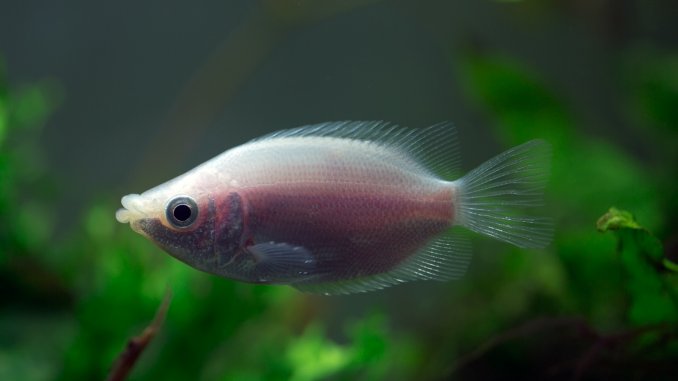
Gouramis are some of the most popular fish around.
Each species has its own charm, but Kissing Gouramis are truly unique.
Their distinctive mouths draw people in, who then fall in love with their personalities. They are becoming more popular as an alternative to the well-known dwarf gourami.
They have some aggressive tendencies, but these are easily minimized if their environment has been designed well.
There is a lot to learn before you can keep your own Kissing Gourami. So keep reading to learn everything you need to know…
TABLE OF CONTENTS
Kissing Gourami Facts & Overview
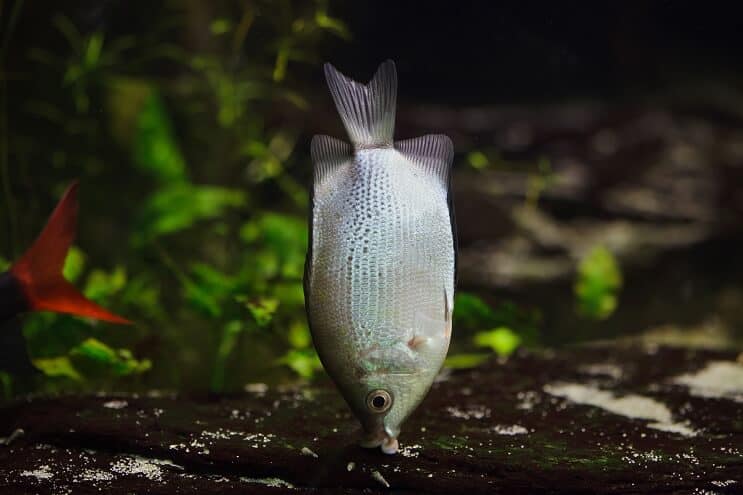
| Category | Rating |
| Care Level: | Intermediate |
| Temperament: | Semi-aggressive |
| Color: | Pink or green |
| Lifespan: | 5-7 years |
| Size: | Up to 12 inches |
| Diet: | Omnivore |
| Family: | Helostomatidae |
| Minimum Tank Size: | 50 gallons |
| Tank Setup: | Freshwater, heavily planted |
| Compatibility: | Community of similarly sized fish |
The Kissing Gourami (Helostoma temminckii) is the only species in the Helostomatidae family. There are many types of gourami, but most are part of the Osphronemidae family.
Also known as Pink Kissing Gourami, Kissing Fish or Kissers, Kissing Gouramis are a favorite for many fish keepers. They are native to Southeast Asia, originating from Thailand and Indonesia.
They have something called a labyrinth organ, which is used to take in oxygen from the air. It’s a useful skill to have, as it allows them to survive in extreme conditions when oxygen in the water gets low.
Most pet stores sell Gourami fish. Dwarf Gourami are the most common, you may have to look around a few shops before you come across Kissing Gourami however.
Each fish costs around $5 each and will live for 5-7 years in a healthy aquarium. Don’t be surprised if they live even longer, some have been known to reach 25 years old!
Typical Behavior
This species gets its name because individuals are often seen “kissing” in the water. While this may sound romantic, it is not. The act is actually a form of fighting over territory, usually between males.
Fighting will reduce as they mature and clearly define their own mating territories.
Occasionally this aggression might be directed towards tank mates. They can be kept in communities, but only with similarly sized fish. They sometimes ram the sides of other fish, which removes their slime coat.
If this happens often you should separate the fish.
This talk of aggression might be off-putting, but aggressive outbursts are infrequent. You will usually see them slowly swimming around the middle and upper levels of the tank.
You might see your Kissing Gouramis head to the surface for oxygen if the water conditions are poor.
Appearance
The first thing you will notice about Kissing Gourami is their distinctive mouth. It protrudes outwards from the body and is unique to this species of Gourami. Their jaw has an additional joint, which increases the angle that their mouth can open, making more food accessible to them.
Lips look like they are pouted, as if ready to kiss, which contributes to their name. Each one is lined with small teeth.
Their body has a similar shape to most Gourami. It is flattened laterally and both sexes can reach up to 12 inches when fully mature (though they are often smaller in captivity).
They have short dorsal and anal fins that run along the body, from the back of the head to the tail fin. The pectoral fins are longer and more rounded.
You will most commonly find them in two main colors: pinkish and silver-green. Some are speckled or piebald. Natural specimens are the green variety, they have brown fins and dark lateral stripes along their body.
A mutated variety has been bred for the aquarium industry which is short and round. Though some people prefer this variety, it is weaker and does not live as long.
Habitat and Tank Conditions
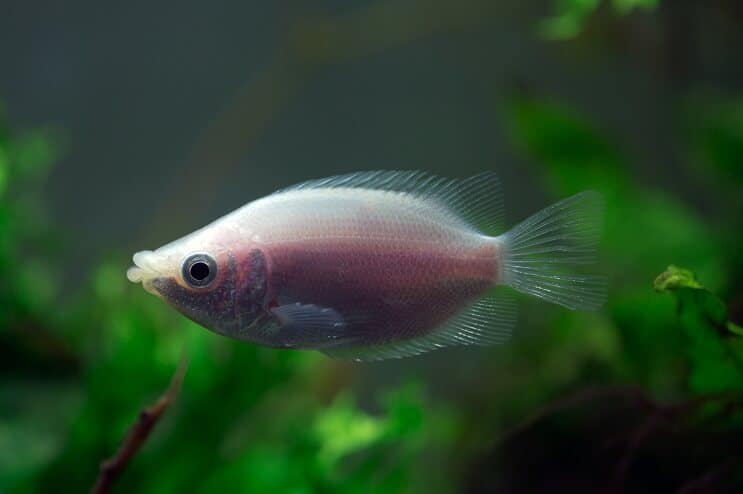
These fish naturally live in the tropical freshwaters of Southeast Asia. They prefer slow-moving water with dense vegetation – ponds and marshes tend to be the most suitable.
Oxygen levels in these habitats might be lower than in rivers with fast currents. Kissing Gourami can survive this by breathing through their labyrinth organ.
The water would be warm with a fairly neutral pH, though these fish are hardy and can survive many different conditions. They live in climates with lots of sunlight, but the abundance of plants can shade the water beneath them.
Tank Setup
Choose a soft substrate to coat the bottom of the tank, fine-grained sands are ideal. Sometimes your Kissing Gourami will poke around the substrate in search of food, so rough gravels might scratch them.
Next, you can pick and place some live plants.
Create some densely planted areas but also leave some open swimming spaces. Do not block off the surface either, these fish will want to head there to breathe occasionally. The plants will need to be fast-growing and strong, or they won’t be able to survive some nibbling from your Kissing Gourami. Java Fern and Hornwort are some durable examples.
This species is used to tropical waters, so heat your water to somewhere in the range of 72-82°F. The pH should be 6-8 and hardness should be 5-20 dGH.
A filter and a heater are the only pieces of equipment you need. Standard aquarium lighting is fine, and they don’t like strong currents so you do not need air or a water pump.
What Size Aquarium Do They Need?
The minimum tank size for a mating pair of Kissing Gourami is 50 gallons.
After the first 50 gallons for a pair, allow a further 30 to 40 gallons per additional fish.
Tank Mates
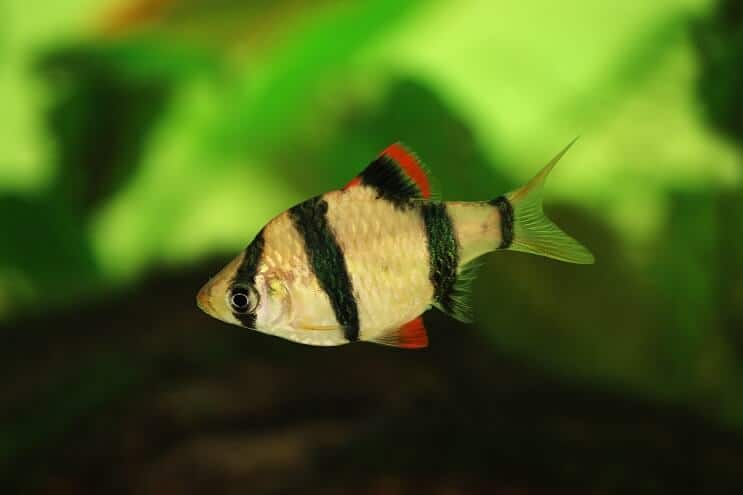
Kissing Gourami can be a great addition to a community aquarium if their tank mates are chosen correctly.
Their tank mates need to be able to cope with their semi-aggressive nature.
Other species of Gourami do not make suitable tank mates because Kissing Gourami are aggressive towards fish that look like themselves.
The best options are hardy and similar-sized fish.
Some good options include Tiger Barbs, Congo Tetra, Archerfish, Swordtails, Rosy Barbs, Angelfish, Pictus Catfish, Clown Loaches, Yoyo Loaches, and Chinese Algae Eaters.
Avoid small species (like certain Tetras) because they are unable to defend themselves and are easily eaten.
If you spot any bullying, you will have to separate the fish.
It is safest to avoid invertebrates as there is a possibility of them being eaten.
Keeping Kissing Gourami Together
Keeping these fish together can be difficult because they direct their aggression towards those fish that look like themselves.
A pair of one male and one female can be kept together with few quarrels. Larger groups can be kept but it is riskier and will require a much larger tank.
Check this out: Cardinal Tetra Complete Care Guide
Diet
Omnivores like these are the easiest fish to feed. They can eat both plants and meat, so anything you add to the tank will be happily gobbled up.
In the wild, plants would make up a large portion of their diet. The tiny teeth on their lips help them to rasp algae from rocks and break down larger vegetation. They would also eat insects should the opportunity arise. They also have gill rakers that filter the water that passes over the gills, helping them to eat plankton.
You can add green vegetables (lettuce, spinach, and zucchini) into the tank to satisfy their need for plant matter.
Live and frozen foods are the best way to replicate the insects and plankton in their natural diet. You could use daphnia, bloodworms, or brine shrimp.
Dried foods (flakes and pellets) can also be used at feeding time. They contain fewer nutrients than live foods, but they are often much more convenient.
If you choose to use dried foods, supplement them with live/frozen foods and vegetables to ensure that your Kissing Gourami get all the nutrients that they need. Foods containing carotenoids help to maintain their color.
Be careful not to overfeed them – once or twice a day, feed them what they can easily finish within two minutes.
Care
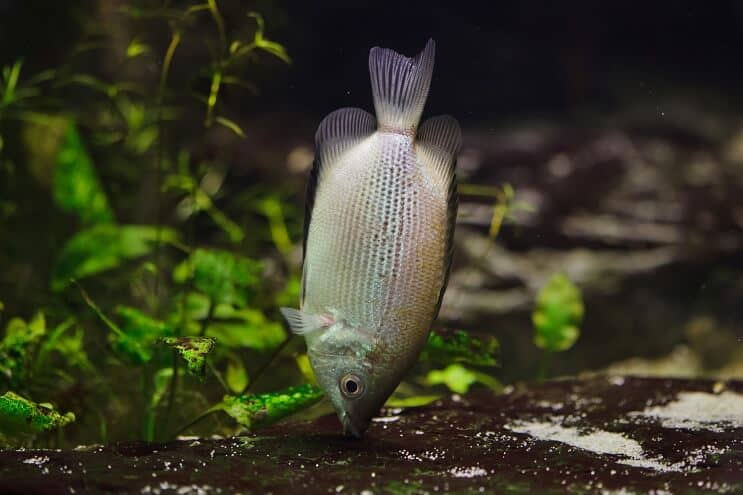
Caring for these fish is like caring for most other aquarium fish, especially other Gourami.
All species need a clean and healthy environment to thrive. If you clean your tank regularly, you will be less likely to experience problems such as algae blooms or diseases.
Try to maintain consistent water conditions as sudden changes can kill your fish or leave them far more prone to illness.
Ideally, the room temperature should not be too different from the water temperature. If there is a big difference, your Kissing Gourami could damage their labyrinth organ when breathing from the air. If this is not possible you can use a lid on top of your tank to trap some warm air above the surface of the water.
Choosing the right diet is also a crucial aspect of Kissing Gourami care. If their diet is not varied and does not contain a range of nutrients, their immune system will weaken.
If everything mentioned so far has been implemented, the disease will be rare because this is a hardy species. Sometimes the disease is unavoidable though – they’re a couple of common ones to be aware of.
Hole in the head disease (HITH) causes pale, eroding holes on an infected fish’s head. These gradually get larger, providing an entry point for other pathogens. Potential causes are uncertain but moving the fish to a different tank without activated carbon often leads to improvement.
Ich (white spot disease) is an ectoparasite that presents as white spots over the body. Other symptoms include a loss of appetite and cloudy eyes. Separate the infected fish as soon as you spot the disease.
Quarantining new fish and cleaning second-hand equipment are the best ways to prevent pathogens from entering your aquarium.
Breeding
When trying to breed a pair of Kissing Gourami, you must first condition them. Do this by feeding them high-quality foods that are full of nutrients. This means increasing the proportion of live foods in their diet.
You also need to create the perfect conditions in your tank. It must be clean and also needs to be at the warmer end of their preferred temperature range (80-82°F).
When ready to mate, the pair will start circling each other. This behavior will intensify until they are beating their tails and kissing.
Unusually for species in this family, Kissing Gouramis do not make a bubble nest when spawning.
The male will wrap himself around the female and turn her upside down, at which point she will release eggs to be fertilized by the male. There could potentially be thousands of eggs released.
Remove the parents once the eggs have risen to the surface. The fry should hatch after a day. They will be too small to eat adult foods so give them infusoria, baby brine shrimp or crushed foods until they mature.
Read this Article: Red Arowana Care Guide: A Fishkeeper’s Crown Jewel?
Are Kissing Gourami Suitable For Your Aquarium?
Kissing Gouramis are an interesting species that show off some unique behaviors.
We have talked about their aggression and how to deal with it, but most of the time they remain peaceful. If you choose the right tank mates, it should not be a problem at all.
They are hardy fish that even beginners will be able to handle if they have done their research.
Diseases are rare and they can tolerate a range of conditions.
Kissing Gouramis make an excellent addition to a community aquarium and will diversify the activities on display.
Do you keep Kissing Gourami in a community tank? Let us know about your setup in the comments section below…

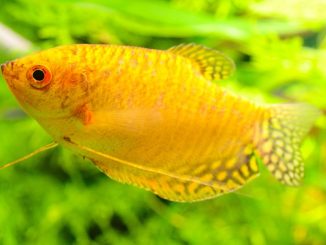
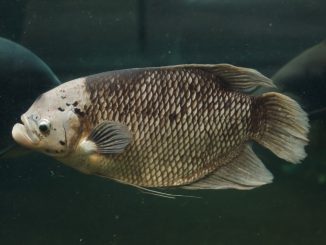
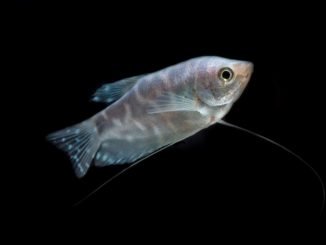
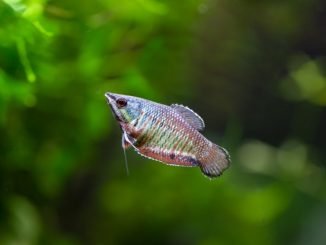
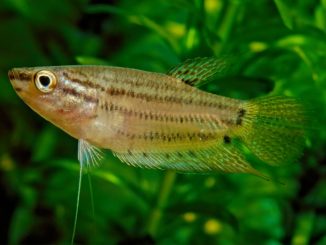
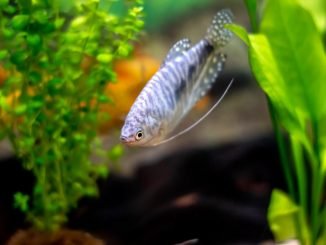
I have a pink kissing gourami from past 1 year . Recently it suffered from anchor worm dieses and got cured by hand picking them it was a tough time for us tho, now my tank consist of two black shark and a kissing gorami with a motor in it.
I have a white kissing gourmi in my 70 litre tank, the fish is 7 yrs old, with only 2 other tank mates piece,and a sml cat fish they always hide. C and I add angle to the tank are they good tank mates.
I’ve had Bubba for the last 4-5 years. He has laid claim to 1/3 of the tank by the out flow. feed him a mix of ghost shrimp, pellets and algae wafers. He leaves the rest of the fish alone for the most part only really chasing them if the go into his corner when there’s no food. Tank mates are tiger barbs, pearl danios, corydoras, rainbow shark, clown pleco, and a raphael catfish. Tank is pretty heavily planted with a variety of plants and 5 amazon swords reaching the top of a 65g tank. Plan on upgrading to a 120 when I move.
Can i add angle fish with my kissing gourmi, which is 7 yrs old baby angle fish, my tank is 70 litre
I have pink bromides and suddenly I have one that back fins and coat is having a different kind of pink color and side fins core are pink. Do u know what is wrong.
I meant pink gromies
WhAT IS THE REQUIREMENT FOR PH FOR KISSING GOURAMIS?
Even though I operated a dog rescue someone with a heart rescued a 10 gallon tank of dirty water full of guppies and one kissing gourami. Rescuer knew I had a 75 gal tank with angels and asked if I would take the gourami, she was keeping guppies (thankfully!) That gourami ended up becoming my favorite fish. One morning I found him wedged into an opening in the (high dollar) faux coral and I had to break the decoration to free him. I also had to set up a hospital tank and take care of him for nearly 3 months(!) until his scales and fins grew back and his spark returned.